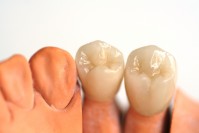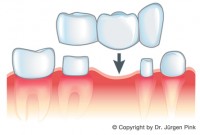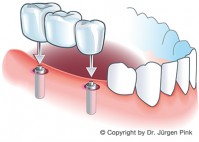A dental prosthesis is also called prosthetics. Inlays, crowns, bridges, partial crowns, or implants are considered to be dental prosthesis as well as dentures or ’third teeth’. The goal of modern prosthetic dentistry is the restoration of the natural function and aesthetics of the dentition. This can be achieved by using resistant materials similar to the natural tooth. Often the dental prosthesis is almost invisible because of its perfect adaption to the natural colour and shape of the tooth thanks to modern technology. This contributes to self-confidence and joy in life – at any age.
It is certainly always better to prevent damage to the teeth rather than treating them afterwards. However, should caries decay occur anyway there are various filling materials and treatment alternatives available in order to restore the function and beauty of the natural teeth. We generally differentiate between inlays made from gold or porcelain and direct acrylic fillings. While acrylic fillings are inserted into the defective area immediately during the session, it takes a few treatment steps to manufacture inlays in our in-house laboratory in collaboration with the dental technician. Which treatment alternative is chosen depends on the extent of the damage and on the patient.

Costum-fit all-porcelain crown
Artificial crowns cap a living or dead tooth within the area of the crown. This is the part of the tooth that is visible outside the gum.
The picture displays an all-porcelain crown mounted on a technical pin. Please note the transitions to the teeth from the margins and the light refractions in different parts of the crown.
In order to prevent that from happening, the gap has to be closed.

Dental bridge carried by natural teeths

Dental bridge carried by dental implants




